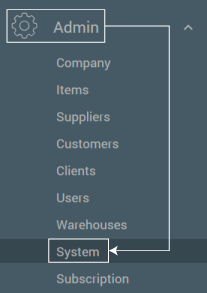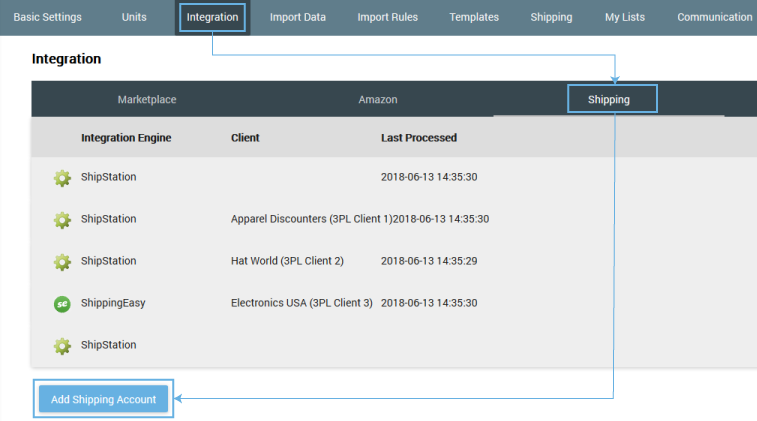ShipStation Integration Functionality (12/10/19):
- Pushes “Ready to Ship” orders from Allocadence into ShipStation
- Pushes a “shipped” status update for ShipStation orders that are manually marked as Complete, Shipped, or Dropshipped in Allocadence
- Pulls updated shipment information from ShipStation into Allocadence (tracking number, carrier info)
- Pulls new orders from ShipStation with “Awaiting Shipment” status into Allocadence if not already present – **Optional**
- Adds a tag of your choice to ShipStation orders that are fully picked in Allocadence – **Optional**
- Pushes a “cancelled” status update for orders marked as cancelled in Allocadence – **Optional**
Update interval (maximum):
- 15 minutes
Configuring the integration:
There are two places where you will need to enter information to set up this integration: From the ShipStation UI and from the Allocadence UI. It will be helpful to have both sites open during this process.
- Start by logging into Allocadence, navigate to the “Admin” tab and select “System“.

- Select Integration, click the Shipping” Tab , and select “Add Shipping Account“.

- Choose ShipStation from the dropdown menu. Click “Add” to create the new integration.

- Log into ShipStation to get your API Credentials.
Navigate to Account Settings -> Account -> API Credentials.


- Copy and paste (Ctrl+C then Ctrl+V) the displayed API Key and API Secret to the matching fields in Allocadence.


- Some final settings to review in Allocadence before finishing your integration:
- Importing User (required) – This is the user account that will be logged as the one accountable for any actions happening related to the ShipStation integration (orders being created or completed, etc.). The user account must have a SecureKey. You can use any existing Admin user account or create a new one if desired.
- Warehouse (optional) – This will determine the default warehouse used for allocation of orders coming from ShipStation. If nothing is entered, system defaults will be used.
 Client (optional – 3PL only) – If you’re a third party fulfillment company that stores inventory for others, you will need to assign a Client to tell Allocadence which of your clients’ inventory this integration should be assigned to.
Client (optional – 3PL only) – If you’re a third party fulfillment company that stores inventory for others, you will need to assign a Client to tell Allocadence which of your clients’ inventory this integration should be assigned to. Tag (optional) – Select a ShipStation tag to apply when orders are fully picked. Gets the list of tags from your ShipStation account, so you’ll need to create a tag there first if one doesn’t exist.
Tag (optional) – Select a ShipStation tag to apply when orders are fully picked. Gets the list of tags from your ShipStation account, so you’ll need to create a tag there first if one doesn’t exist.- Use ‘Ship From’ Location
- If checked, Allocadence will try to allocate stock first from the ‘Ship From’ warehouse name specified by ShipStation for the order. ** Only recommended to enable this if your ‘Ship From’ warehouse names in ShipStation will exactly match your warehouse names in Allocadence. If there is a mismatch, or if the named warehouse doesn’t exist yet in Allocadence, it will be created automatically when the order downloads.
- (DEFAULT) If unchecked, Allocadence will ignore the ShipStation-specified ‘Ship From’ warehouse name and follow the default behavior for choosing what warehouse to use.
- Lock ‘Ship From’ Location
- With this setting enabled, the originally specified ‘Ship From’ warehouse designated by ShipStation for a particular order will be used to determine allocation, even if that variable is later changed inside ShipStation.
- If unchecked, Allocadence will be allowed to receive any updates to the ‘Ship From’ location from ShipStation and to use the new warehouse for allocating stock, assuming the order items have not already been fully allocated.
- Shipments Only
- If checked, Allocadence will simply post orders to ShipStation for shipping when they are ready, and will not attempt to download new orders from ShipStation. Check this box only if all your marketplaces are connected directly to Allocadence rather than ShipStation.
- If unchecked, Allocadence can both send orders to and receive orders from ShipStation. Leave unchecked if your marketplaces are connected to ShipStation rather than Allocadence. (Default setting)
How to test and confirm functionality after integrating:
- Create a test order in any ShipStation-connected marketplace. See if it downloads successfully to ShipStation. Timing for this is dependent on the integration. If it doesn’t download at all, there is an issue to troubleshoot in the integration between your connected marketplace and Shipstation.
- See if the order in ShipStation downloads to Allocadence. It should pull in every 15 minutes automatically. If it doesn’t, confirm that the “Store” in ShipStation where the order originated is mapped to the correct ShipStation integration in Allocadence (if you have more than one), using the Store Selector in the integration settings.
- Create a test order in Allocadence. See if it uploads successfully to ShipStation (every 15 minutes). The order will be posted into ShipStation’s “Manual Store” and should be able to be shipped.
- Make sure both test orders are in the “Ready to Ship” status in Allocadence, and then ship them in ShipStation. The orders should move to Dispatched status in Allocadence automatically and have tracking numbers applied (every 15 minutes).
Reasons an order might get missed by our integration:
- The order was in a status other than “Awaiting Shipment” when our system looked for it. Our system only pulls in orders that are in the “Awaiting Shipment” status, so if it was “On Hold” or any other status, that would prevent it from downloading.
- The order was lacking some piece of information that is required in order to import to our system. Occasionally, we come across orders in ShipStation that for some reason don’t have a name or Ship-To address, which would present a problem for our importer.
- The order was shipped too quickly for us to pick it up (example: an order that was shipped within minutes of being downloaded into ShipStation). Allocadence checks for new orders at a 15 minute interval, so if it was shipped more quickly than that, there’s a chance that the order moved out of the required “Awaiting Shipment” status before we could catch it.
